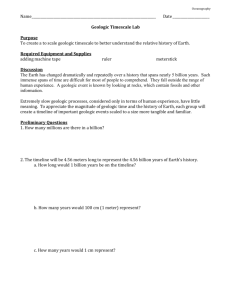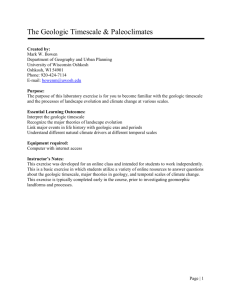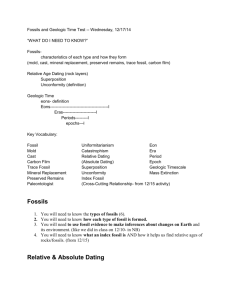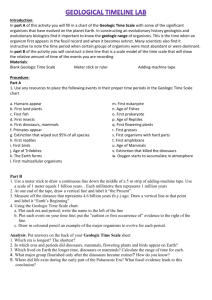Investigating Geologic Time
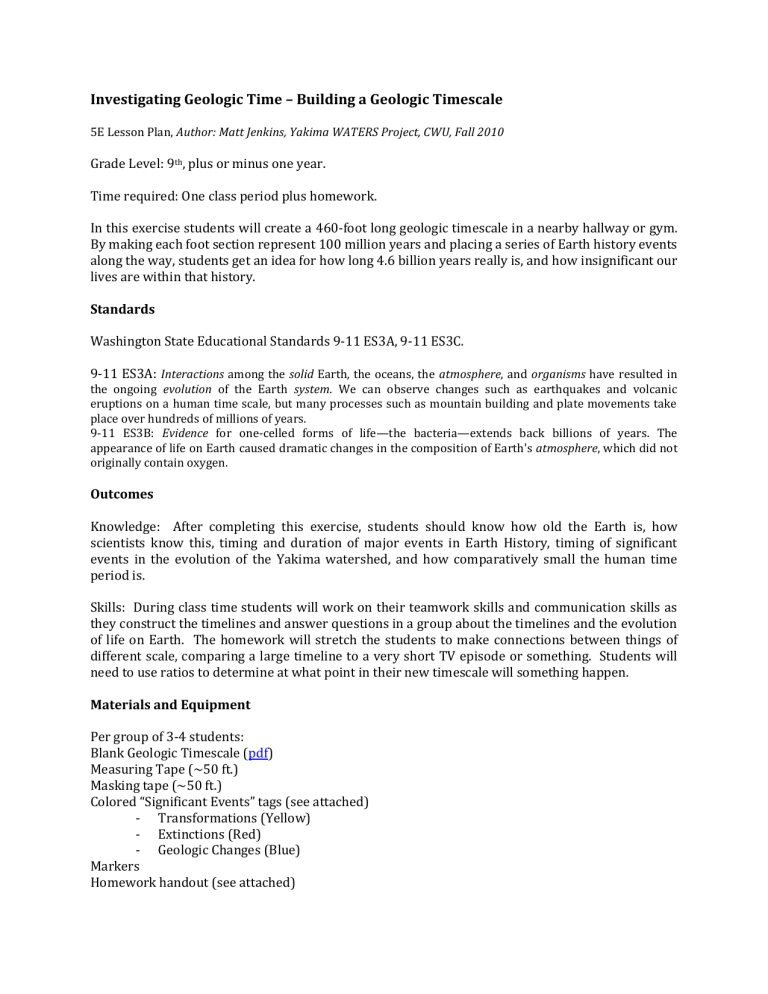
Investigating Geologic Time – Building a Geologic Timescale
5E Lesson Plan, Author: Matt Jenkins, Yakima WATERS Project, CWU, Fall 2010
Grade Level: 9 th , plus or minus one year.
Time required: One class period plus homework.
In this exercise students will create a 460-foot long geologic timescale in a nearby hallway or gym.
By making each foot section represent 100 million years and placing a series of Earth history events along the way, students get an idea for how long 4.6 billion years really is, and how insignificant our lives are within that history.
Standards
Washington State Educational Standards 9-11 ES3A, 9-11 ES3C.
9-11 ES3A: Interactions among the solid Earth, the oceans, the atmosphere, and organisms have resulted in the ongoing evolution of the Earth system. We can observe changes such as earthquakes and volcanic eruptions on a human time scale, but many processes such as mountain building and plate movements take place over hundreds of millions of years.
9-11 ES3B: Evidence for one-celled forms of life—the bacteria—extends back billions of years. The appearance of life on Earth caused dramatic changes in the composition of Earth's atmosphere, which did not originally contain oxygen.
Outcomes
Knowledge: After completing this exercise, students should know how old the Earth is, how scientists know this, timing and duration of major events in Earth History, timing of significant events in the evolution of the Yakima watershed, and how comparatively small the human time period is.
Skills: During class time students will work on their teamwork skills and communication skills as they construct the timelines and answer questions in a group about the timelines and the evolution of life on Earth. The homework will stretch the students to make connections between things of different scale, comparing a large timeline to a very short TV episode or something. Students will need to use ratios to determine at what point in their new timescale will something happen.
Materials and Equipment
Per group of 3-4 students:
Blank Geologic Timescale ( pdf )
Measuring Tape (~50 ft.)
Masking tape (~50 ft.)
Colored “Significant Events” tags (see attached)
Transformations (Yellow)
Extinctions (Red)
Geologic Changes (Blue)
Markers
Homework handout (see attached)
Prior Knowledge
The assumption is that students have some idea that the Earth is very old. Depending on their middle school education they may have a very good idea, or they may be completely lost. The expectation is also that they may incorrectly assume that human history represents a disproportionally large piece of geologic time. Preconceptions are assessed by a short engage activity asking them to place a limited number of events on a blank timescale.
Safety
There will be minimal safety concerns in this exercise. Students will be using scissors to cut paper, markers, and measuring tapes. Important that care is taken with measuring tapes, and not allowed to “snap-back” into the holder. Students will be working in hallways and will require supervision.
Engage (10 min)
To assess students’ preconceptions, as well as introduce students to the geologic time scale, distribute one blank geologic time scale to each group of 3-4 students. As a team, have them place several key events where they think they occurred in Earth’s history. Events (actual dates listed in parentheses): Oldest Rocks Found on Earth (4,400 million years ago [ma]), First Evidence of Life
(3,850 ma), Dinosaurs Become Extinct (65 ma), Modern Humans (100,000 years ago). Interesting trivia: a book with one page for every year would be 145 miles long and take you 17,500 years to read.
Explore (30 min)
Students now will create their own time scales in their groups. (Optional depending on class size: combine students into three groups to complete three time scales, one for events, one for extinctions, and one for geologic changes). In a nearby hallway, gym, or other appropriate location, use the measuring tape and masking tape to mark a line 46 feet in length on the floor. Use markers to divide the line into 46 one-foot sections, each representing 100 million years. Label “Today” at the top (or left), “4,600 ma” at the bottom (or right), and some of the 100 ma marks for easy reference (every 500 ma). Then, cut out the printed events and arrange these events along your time scale according to their date.
Explain (10-15 min)
Students will be given a short in-class assignment to complete asking them questions about their timescales and the activity. Give each group one question to report their answers to the class and discuss the answers in the last minutes of class.
Questions to answer:
1) In what ways do evolutionary events correspond to other types of events during the history of life?
2) How might extinctions affect the evolution of organisms that survive the event?
3) In what ways have geologic changes influenced evolutionary events and/or extinctions?
4) How does the length of the history of life help to explain the evolutionary events of singlecelled organisms to complex multicellular organisms like mammals?
Elaborate (Homework)
To encourage students to apply their knowledge to a new scenario, students will be given a homework assignment, due at the end of the week. The assignment (attached), will guide them in creating their own geologic timescale within the time frame of something else. For example, a calendar year, a football game, a typical TV show, etc. Students will be told in-class that they need to choose ten events that they will incorporate in their timescales.
Evaluate (30 min)
Evaluation will be based on in-class work, appropriate use of time, teamwork, and completion of the homework assignment. In-class work will be graded primarily on completion of the questions asked, and discussion/input of all team members. Responses will be graded on their thoroughness and demonstrated ability to incorporate a variety of ideas. Class time is given for the students to construct their timescales according to the directions supplied, as well as for the students to complete the pre-test, post questions, and discuss each. Students will be graded on appropriate use of this time. One of the most important pieces of assessing students on this lesson is how well they can work together to construct their timescale, place the appropriate events, and discuss the questions after. The homework assignment establishes a link between information learned in the classroom exercises and encourages students to apply their knowledge in a new way.
Performance Rubric
Element
On-task time
(30%)
Teamwork
(25%)
In-class questions
(15%)
Excellent
(5 pts)
Student is ontask ~100%, can manage to keep others on task as well.
Student works to a “good” level but actively seeks out input from teammates by asking questions, delegating tasks, and willing to have tasks delegated to them.
Questions are answered correctly, completely, and grammatically correct.
Students have discussed with group and all
Good
(4 pts)
Student is on-task
~90% of time, working positively towards completion of assignments.
Student works well with team, team completes tasks on time and tasks are shared equally. Student discusses questions with team and makes connections to timescale.
Students answer all questions fully and correctly.
Connections may be made, but not solid, obvious they thought about answers, some grammar
In
Development
(3 pts)
Student participates minimally, is on-task ~75% of class time.
Student provides some input to questions, but only simplistic answers, often not on task. OR student completes all tasks without listening to input of others.
Students answer all questions, responses are minimal, some connections are made, poor english/gramm ar, responses
Needs
Rethinking
(2 pts)
Student is idle in class, does not distract others but does not participate.
On-task ~50% of time.
Student provides minimal input, only helps with physical tasks, does not provide input to questions in the pre-test or the in-class assignment.
Students answer almost all questions, but not complete sentences, connections are not made, answers
Not Scorable
(1 pt)
Student does not participate, is a distraction to others. Ontask ~25% of time.
Student does not provide input to the group. Copies answers, does not help construct timescale, does not provide input to discussions.
Students provide minimal responses, some questions unanswered.
Homework
(30%) correct ideas are present.
Solid connections are made between events.
Student uses original timescale, is neat and complete.
Student places all dates correctly on timescale.
Student demonstrates they went above and beyond with creativity.
Teacher Background Info errors/incomplet e answers.
Answer lack depth but exist.
Timescale is complete, neat, and all dates are correct and placed appropriately on the student’s timescale. Lacks creativity of a 5 point response, maybe uses in class examples. demonstrate mediocre effort.
Timescale is complete, student applies timeline to something other than calendar year, but maybe uses in class example. Dates are mostly correct and applied correctly. demonstrate they have not thought about the questions, merely trying to finish.
Timescale is mostly complete but lacks creativity.
Obvious that student put in minimal effort.
Dates for events are wrong or interpolated wrong onto new timescale.
Student does not complete timescale, timescale is copied from another source, timescale does not demonstrate any creativity.
Scientists have determined with great confidence that the Earth is 4.54 billion years old. This is based on radiometric dating of meteorites (particularly one found in Arizona) and agrees well with ages determined from dating lunar samples, estimating cooling rates, studies of our sun, and host of other methods. The oldest rocks on Earth are in the Jack Hills of Western Australia and were dated to 4.4 billion years by dating tiny minerals called zircons. The majority of ages we have for any types of events are determined by the radioactive decay of certain isotopes. Depending on how old something is, different methods can be used. A lot of assumptions are made when using radiometric dating, such as that decay rates remain constant over time, but in general the science behind dating methods is very sound. This Wikipedia article contains much of the above information (in more detail) and an excellent description of radiometric dating. http://en.wikipedia.org/wiki/Age_of_the_Earth
Resources
This lesson was adapted from the lesson found here: http://www.teachersdomain.org/resource/tdc02.sci.life.div.lp_divdeeptime/
Interesting facts about how long earth history is: http://www.ucmp.berkeley.edu/education/explorations/tours/geotime/gtpage1.html
Blank geologic time scale: http://serc.carleton.edu/files/introgeo/interactive/examples/bgeotime.pdf
Wikipedia article on Age of the Earth: http://en.wikipedia.org/wiki/Age_of_the_Earth
Events:
Evolutionary events (Light Blue):
First evidence of life (3,850 million years ago [ma])
Oldest fossils (3,500 ma)
First evidence of soft-bodied animals (900 ma)
The Cambrian Explosion (530 ma)
First land plants and fish (480 ma)
First reptiles (350 ma)
First mammals and dinosaurs (220 ma)
First birds (150 ma)
First hominids (5.2 ma)
Modern humans (0.1 ma)
Extinctions (Red):
Some single-celled animals and soft-bodied animals (Vendian 543 ma)
Reef-builders and other shallow-water organisms (Cambrian 520 ma)
Ninety percent of all species (End Permian 250 ma)
Dinosaurs and 60 to 80 percent of all species (End Cretaceous 65 ma)
Foraminifera, gastropods, and sea urchins (Late Eocene 33 ma)
Many woodland, plant-eating herbivores (Miocene 9 ma)
Nearly all mammals and birds over 45 lbs. (Late Pleistocene 0.1 ma)
Geologic Events (Yellow):
Formation of the great oceans (4,200 ma)
Continents begin shifting (3,100 ma)
Rodinia supercontinent breaks up (700 ma)
Gondwana forms (500 ma)
Great mountain ranges form (425 ma)
Formation of Pangaea supercontinent (280 ma)
Pangaea supercontinent breaks up (200 ma)
Mt. Stuart and the Stuart Range is formed (96 ma)
Ancestral Cascade Mountains form (37 ma)
Inland seas dry up (20 ma)
Columbia River Basalts (forming most of the bedrock of Eastern WA) (17 ma)
Global ice ages begin (2 Ma)
Constructing a Geologic Timescale
Introduction:
When most of you think of ancient history, we think of Greece, Ancient Rome, maybe even the Egyptians. However, these civilizations are only thousands of years old, whereas scientists have determined that Earth history is BILLIONS of years old. To put this in perspective, if you were to write a book using one page for every year of Earth history, the book would have 4,600,000,000 pages, be a 145 miles thick, and take 17,500 years to read! In class today we will investigate another way to investigate the concept of “deep time” by creating a to-scale geologic timescale. In your table group, collect the following supplies:
Materials:
One measuring tape
One roll of masking tape
One bag of “events”
Markers
Procedure:
With your group, measure out a line of masking tape 46 feet long. Using the markers, divide the tape into 46 one-foot sections. These sections each represent 100 million years of Earth history.
Label the top (or left side) “Today,” and the bottom (or right side) “4,600 ma.” Ma stands for “mega annum” which means million years. You may want to label some of the 100 million year marks for reference.
You also have a plastic bag full of cut-out events in Earth’s history. Mark a line on your timescale and place the title of the event at the appropriate date.
Place each of the events in the appropriate location on your timescale and then answer the following questions:
1) What patterns do you notice about events of a similar color? Give each color group a name based upon the patterns you observe. a.
Blue: b.
Red: c.
Yellow:
2) How might extinctions affect the evolution of organisms that survive the event?
3) In what ways have geologic changes influenced evolutionary events and/or extinctions?
4) How does the length of the history of life help to explain the evolution of single-celled organisms to complex organisms like mammals?
Once you’ve answered all the questions, clean up your timescales placing the events back in the bags, tape in the garbage, and returning the other supplies to the front of the classroom.
Create Your Own Geologic Timescale
DUE:
Task:
On Wednesday, we created large-scale geologic timescales in your table groups. For homework, due at the end of the week, you will be required to create one of your own, set within the timeframe of something else. For example, the geologic timescale set within a regular calendar year, or the length of one day. So, at exactly dawn, the Earth is formed, somewhere in the evening the dinosaurs go extinct, and just seconds before midnight modern humans evolve. To calculate when a particular event should happen in YOUR timescale, you need to figure out at what FRACTION of time it happened in Earth History.
For example, the first reptiles appeared 350 million years ago. 350 million/4600 million
(age of the Earth) = 0.076. So, if you were to use the example of one day, you would find the number of seconds in a day (24 hours x 60 minutes x 60 seconds = 86,400 seconds in one day). Now, multiply 86,400 seconds by 0.076 = 6,566 seconds before present, or 109 minutes, or 10:11 pm. BE CREATIVE!
Create Your Own Geologic Timescale
DUE:
Task:
On Wednesday, we created large-scale geologic timescales in your table groups. For homework, due at the end of the week, you will be required to create one of your own, set within the timeframe of something else. For example, the geologic timescale set within a regular calendar year, or the length of one day. So, at exactly dawn, the Earth is formed, somewhere in the evening the dinosaurs go extinct, and just seconds before midnight modern humans evolve. To calculate when a particular event should happen in YOUR timescale, you need to figure out at what FRACTION of time it happened in Earth History.
For example, the first reptiles appeared 350 million years ago. 350 million/4600 million
(age of the Earth) = 0.076. So, if you were to use the example of one day, you would find the number of seconds in a day (24 hours x 60 minutes x 60 seconds = 86,400 seconds in one day). Now, multiply 86,400 seconds by 0.076 = 6,566 seconds before present, or 109 minutes, or 10:11 pm. BE CREATIVE!
